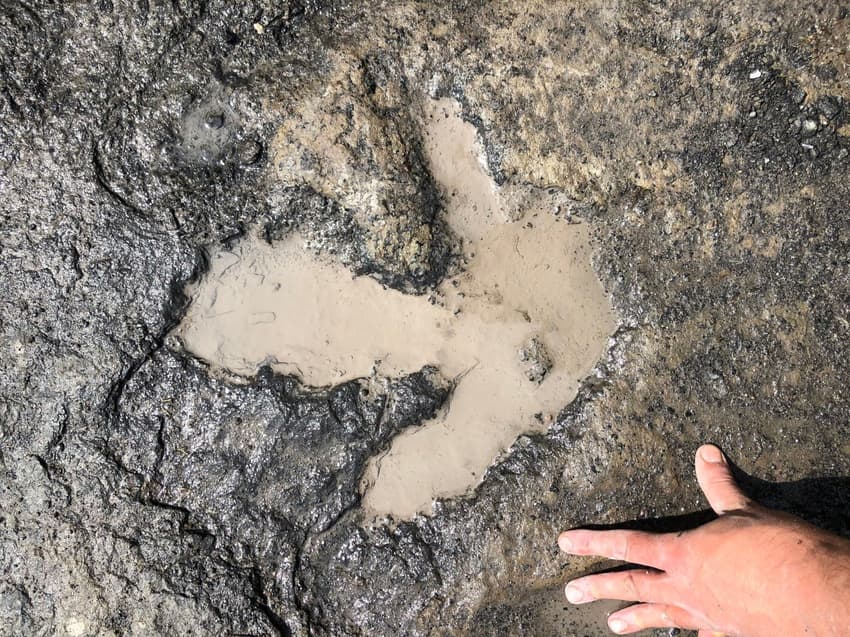New dinosaur finds in Sweden 'completely rewrite history'

Researchers have uncovered some of the oldest fossils of large predatory dinosaurs ever found at an old clay quarry in the town of Billesholm in Skåne, southern Sweden.
Four tons of fossil material has now been transported from Billesholm in northwestern Skåne to Uppsala University, bringing together a total of 8,000 individual finds made at the site over the last seven years, according to a report in the Sydsvenskan and Helsingborgs Dagblad newspapers.
"The fact that we had dinosaurs at the end of the Triassic period is not new, but having such large predatory dinosaurs, that's completely unique," paleontologist Martin Qvarnström from Uppsala University told TT newswire.
The dinosaurs in question are huge, he explained, adding that footprints indicate they could have been up to ten metres long.
"It completely rewrites history," he said, "as now we have something more similar to what we see much later in dinosaur evolution."
Researchers at the site have found remains of several previously undiscovered dinosaur species, which are up to 201 million years old.
Preliminary analysis suggests this could be one of the world's oldest discoveries of large predatory dinosaurs from the latter part of the Triassic period.
Researchers working on dinosaur remains at an old clay quarry in Billesholm in Skåne. Photo: Uppsala universitet/TT
By the end of the Triassic period, dinosaurs had already existed for 30 million years, but not much is known about their early existence.
"Here, we have a very early ecosystem which is dinosaur-dominated, and we're trying to understand why that is the case," Qvarnström said.
The researchers have discovered clear dinosaur footprints, as well as bones and fossilized dinosaur dung. Samples of fossilised trees, plants and invertebrates have also been collected.
The ambition is that the finds, taken together with samples from different layers of sediment from the site, can shed light on how the ecosystem functioned. This is possible due to the large amount of samples from the same area.
The finds were collected between 2015 and this year and will now be analysed, with the results published in scientific articles.
"We have material which will keep us busy for another ten years," Grzegorz Niedzwiedzki, the paleontologist who led the dig at Billesholm, told Sydsvenskan and Helsingborgs Dagblad.
Comments
See Also
Four tons of fossil material has now been transported from Billesholm in northwestern Skåne to Uppsala University, bringing together a total of 8,000 individual finds made at the site over the last seven years, according to a report in the Sydsvenskan and Helsingborgs Dagblad newspapers.
"The fact that we had dinosaurs at the end of the Triassic period is not new, but having such large predatory dinosaurs, that's completely unique," paleontologist Martin Qvarnström from Uppsala University told TT newswire.
The dinosaurs in question are huge, he explained, adding that footprints indicate they could have been up to ten metres long.
"It completely rewrites history," he said, "as now we have something more similar to what we see much later in dinosaur evolution."
Researchers at the site have found remains of several previously undiscovered dinosaur species, which are up to 201 million years old.
Preliminary analysis suggests this could be one of the world's oldest discoveries of large predatory dinosaurs from the latter part of the Triassic period.
By the end of the Triassic period, dinosaurs had already existed for 30 million years, but not much is known about their early existence.
"Here, we have a very early ecosystem which is dinosaur-dominated, and we're trying to understand why that is the case," Qvarnström said.
The researchers have discovered clear dinosaur footprints, as well as bones and fossilized dinosaur dung. Samples of fossilised trees, plants and invertebrates have also been collected.
The ambition is that the finds, taken together with samples from different layers of sediment from the site, can shed light on how the ecosystem functioned. This is possible due to the large amount of samples from the same area.
The finds were collected between 2015 and this year and will now be analysed, with the results published in scientific articles.
"We have material which will keep us busy for another ten years," Grzegorz Niedzwiedzki, the paleontologist who led the dig at Billesholm, told Sydsvenskan and Helsingborgs Dagblad.

Join the conversation in our comments section below. Share your own views and experience and if you have a question or suggestion for our journalists then email us at [email protected].
Please keep comments civil, constructive and on topic – and make sure to read our terms of use before getting involved.
Please log in here to leave a comment.